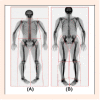Leg strength and lean mass symmetry influences kicking performance in Australian football
- PMID: 24570620
- PMCID: PMC3918553
Leg strength and lean mass symmetry influences kicking performance in Australian football
Abstract
Differential loading patterns during game-based participation may produce or exacerbate strength imbalances between the lower limbs. It is currently unknown whether such imbalances are functionally beneficial or detrimental to performance. This study assessed the influence of lower limb strength and lean mass symmetry on kicking accuracy in Australian Football. Thirty-one Australian footballers were required to perform a kicking assessment, producing ten drop punt kicks over twenty metres to a player target. Athletes were subsequently separated into accurate (n = 15) and inaccurate (n = 16) groups, with lower-body lean mass assessed using whole body DXA scans, and lower-body strength assessed using an isometric protocol. Accurate kickers demonstrated significantly higher relative lean mass (~8% to 16%; p = 0. 001 to 0.004) and significantly lower relative fat mass (~21% to 40%; p = 0.001 to 0.024) than inaccurate kickers. Accurate kickers did not contain any significant difference in lean mass or unilateral strength between lower limbs. Inaccurate kickers displayed significant asymmetry in lean mass (~3%; p ≤ 0.003), producing significant imbalances in strength (~8%; p ≤ 0.002) highlighting a deficiency in their support leg. Greater relative strength and improved lower limb symmetry in strength and muscularity could increase the capacity of an athlete to be technically proficient in favour of greater accuracy. Key PointsStrength deficits in the support leg may lead to inaccurate kicking outcomes.An asymmetry of 3% in lean mass generated an 8% imbalance in leg strength.Greater levels of relative lower-body strength and muscle mass are associated with improved kicking accuracy performance.
Keywords: Laterality; asymmetry; dominance; imbalance; muscularity; strength; unilateral.
Figures



Similar articles
-
Relationship between Leg Mass, Leg Composition and Foot Velocity on Kicking Accuracy in Australian Football.J Sports Sci Med. 2016 May 23;15(2):344-51. eCollection 2016 Jun. J Sports Sci Med. 2016. PMID: 27274674 Free PMC article.
-
Leg mass characteristics of accurate and inaccurate kickers--an Australian football perspective.J Sports Sci. 2013;31(15):1647-55. doi: 10.1080/02640414.2013.793377. Epub 2013 May 20. J Sports Sci. 2013. PMID: 23687978
-
Kicking foot swing planes and support leg kinematics in rugby place kicking: Differences between accurate and inaccurate kickers.Eur J Sport Sci. 2019 May;19(4):451-460. doi: 10.1080/17461391.2018.1519039. Epub 2018 Sep 15. Eur J Sport Sci. 2019. PMID: 30221585
-
Kinematic patterns associated with accuracy of the drop punt kick in Australian Football.J Sci Med Sport. 2006 Aug;9(4):292-8. doi: 10.1016/j.jsams.2006.06.007. Epub 2006 Jul 18. J Sci Med Sport. 2006. PMID: 16854625
-
Enhancing foot velocity in football kicking: the role of strength training.J Strength Cond Res. 2011 Feb;25(2):561-6. doi: 10.1519/JSC.0b013e3181bf42eb. J Strength Cond Res. 2011. PMID: 20375741 Review.
Cited by
-
Genetic Variants within NOGGIN, COL1A1, COL5A1, and IGF2 are Associated with Musculoskeletal Injuries in Elite Male Australian Football League Players: A Preliminary Study.Sports Med Open. 2022 Oct 11;8(1):126. doi: 10.1186/s40798-022-00522-y. Sports Med Open. 2022. PMID: 36219268 Free PMC article.
-
Relationships between physical fitness characteristics, technical skill attributes, and sports injury in female Australian football players.PLoS One. 2024 Feb 22;19(2):e0298267. doi: 10.1371/journal.pone.0298267. eCollection 2024. PLoS One. 2024. PMID: 38386636 Free PMC article.
-
Characterising lower-body musculoskeletal morphology and whole-body composition of elite female and male Australian Football players.BMC Sports Sci Med Rehabil. 2022 Sep 6;14(1):168. doi: 10.1186/s13102-022-00561-8. BMC Sports Sci Med Rehabil. 2022. PMID: 36068592 Free PMC article.
-
Interval Kicking Program for the Punting and Place-Kicking Athlete: A Systematic Literature Review and Need Analysis.Cureus. 2021 Nov 18;13(11):e19725. doi: 10.7759/cureus.19725. eCollection 2021 Nov. Cureus. 2021. PMID: 34934588 Free PMC article. Review.
-
Applied Sport Science of Australian Football: A Systematic Review.Sports Med. 2018 Jul;48(7):1673-1694. doi: 10.1007/s40279-018-0919-z. Sports Med. 2018. PMID: 29633084
References
-
- Andersen L.L., Aagaard P. (2006) Influence of maximal muscle strength and intrinsic muscle contractile properties on contractile rate of force development. European Journal of Applied Physiology 96(1), 46-52 - PubMed
-
- Baczkowski K., Marks P., Silberstein M., Schneider-Kolsky M.E. (2006) A new look into kicking a football: an investigation of muscle activity using MRI. Australasian Radiology 50(4), 324-329 - PubMed
-
- Ball K. (2011) Kinematic comparison of the preferred and non-preferred foot punt kick. Journal of Sports Sciences 29(14), 1545-1552 - PubMed
-
- Dichiera A., Webster K.E., Kuilboer L., Morris M.E., Bach T.M., Feller J.A. (2006) Kinematic patterns associated with accuracy of the drop punt kick in Australian Football. Journal of Science and Medicine in Sport 9(4), 292-298 - PubMed
-
- Gissis I., Papadopoulos C., Kalapotharakos V.I., Sotiropoulos A., Komsis G., Manolopoulos E. (2006) Strength and speed characteristics of elite, subelite, and recreational young soccer players. Research in Sports Medicine 14(3), 205-214 - PubMed
LinkOut - more resources
Full Text Sources
